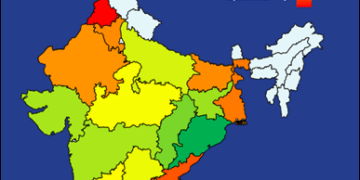Origins and Identity
The Birhors are believed to be descendants of the proto-Australoid racial group and belong linguistically to the Mundari family. Oral traditions suggest that they were once part of larger tribal groups like the Mundas but chose to remain in forested areas while others transitioned to settled agricultural lifestyles. Their identity as “men of the forest” reflects their deep connection to nature and their reliance on forest resources for sustenance.
Traditionally, the Birhors were semi-nomadic hunters and trappers, specialising in capturing monkeys, birds, and small game. They also gathered forest produce such as fruits, roots, tubers, honey, and medicinal plants. Over time, rope-making from tree fibres became a significant economic activity for the tribe, earning them the nickname “rope-makers” among neighbouring communities.
Traditional Lifestyle
1. Hunting and Food Gathering
Hunting was central to Birhor culture. They used handmade nets, bows, arrows, and traps to catch animals like monkeys, hares, and birds. Monkey hunting (locally known as Gari-Sendra) was not only a livelihood activity but also a ritualistic event involving community participation. However, with the depletion of wildlife due to deforestation and industrialisation, this practice has largely disappeared.
The Birhors also relied heavily on forest produce for food. They collected edible plants like Bhathua sag (wild spinach) and Mahua fruits, which served as staples in their diet. Mahua had multiple uses—it was consumed as food, used in traditional medicine, and fermented into an alcoholic drink.
2. Rope-Making
Rope-making is a hallmark of Birhor craftsmanship. Traditionally, they used fibres from trees like Mohlan or Bauhinia creepers to create durable ropes for personal use and trade. In recent years, due to declining access to forests and modern influences, they have adapted by using plastic sacks provided by industrial entities like Tata Steel. Despite these changes, rope-making remains a primary source of income for many Birhor families.
3. Housing: The Kumba
Birhor settlements consist of small huts called Kumba, made from bamboo poles, leaves, and branches. These huts are designed to suit their nomadic lifestyle—they are easy to construct and dismantle when moving locations. The architecture reflects their deep understanding of environmental conditions; for example, huts are elevated during monsoons to avoid flooding.
Social Organisation
The Birhor tribe is organised into clans with strong kinship ties. Each settlement is led by a Mukhia (village headman), who resolves disputes and oversees community affairs. Their social structure is egalitarian but deeply rooted in tradition. Rituals play an essential role in daily life—births, marriages, hunts, and even rope-making are accompanied by ceremonies invoking their deities.
Their belief system is animistic and nature-centric. Deities like Sing Bonga (Sun God) and Buru Bonga (God of Hills) are worshipped through offerings of animals or handmade liquor. Sacred groves near their settlements serve as spiritual centres where rituals are performed before significant activities like hunting.
Challenges Faced by the Birhors
1. Loss of Forest Access
Deforestation due to industrialisation and urbanisation has severely impacted the Birhors’ traditional lifestyle. Forests that once provided food, raw materials for rope-making, and hunting grounds have been degraded or restricted under conservation laws. The National Forest Policy has further limited their access to these resources without offering viable alternatives.
2. Economic Marginalisation
The transition from a nomadic lifestyle to settled agriculture has been fraught with challenges for the Birhors. Government initiatives aimed at settling them often provide low-quality land unsuitable for farming. Many Birhors lack agricultural knowledge or resources like seeds and tools to make farming sustainable. As a result, they continue to rely on precarious activities like rope-making or daily wage labour.
3. Health and Nutrition
Malnutrition is widespread among the Birhor community due to their limited access to diverse food sources after losing forest rights. Starvation deaths have been reported in some settlements despite government welfare schemes like ration cards under the Public Distribution System (PDS). Poor healthcare access exacerbates their vulnerability.
4. Cultural Erosion
Modern influences have led to significant cultural changes among the Birhors. Traditional practices like monkey hunting have vanished due to ecological constraints and legal restrictions on wildlife hunting. Younger generations are increasingly disconnected from ancestral knowledge as they migrate to cities for work or education.
5. Low Literacy Rates
Education levels among the Birhors remain abysmally low due to poverty and lack of infrastructure in remote areas where they live. Illiteracy makes them vulnerable to exploitation by landlords or employers in urban settings.
Government Interventions
Post-independence efforts by the Indian government aimed at integrating the Birhors into mainstream society include:
- Providing agricultural land and tools
- Building permanent housing under welfare schemes
- Establishing schools and vocational training centres
- Promoting rope-making through cooperatives
However, these interventions have largely failed due to poor implementation and lack of cultural sensitivity. For example:
- Houses built under government schemes often lack basic amenities like doors or proper roofing.
- Agricultural initiatives fail because most Birhors lack farming skills or access to irrigation.
- Welfare programmes like MNREGA (employment guarantee) often exclude them due to bureaucratic inefficiencies.
The Way Forward
- Strengthen Forest Rights: Policies should ensure sustainable access to forests for traditional activities like gathering rope materials or medicinal plants.
- Improve Livelihood Options: Rope-making cooperatives can be supported with better raw materials and market linkages.
- Enhance Education: Mobile schools tailored to nomadic lifestyles can help improve literacy rates while respecting cultural practices.
- Healthcare Access: Mobile health units can address malnutrition and diseases prevalent among remote tribal communities.
- Cultural Preservation: Efforts should be made to document oral traditions, rituals, crafts, and languages before they disappear.


















